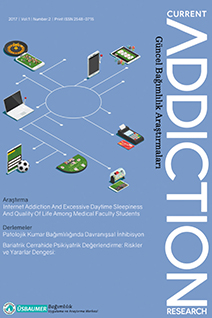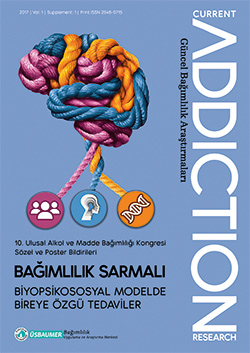Years
2017
Categories
Authors
- Ahmet Yılmaz (1)
- Alptekin Çetin (1)
- Aslıhan Polat (1)
- Cemal Onur Noyan (1)
- Erkal Erzincan (1)
- Erol Göka (1)
- Fatma Eren (1)
- Gürler Güz (1)
- Hasan Kaya (1)
- Hatice Turan (1)
- Hatice Özyıldız Güz (1)
- Nermin Gündüz (1)
- Nesrin Dilbaz (1)
- Onur Gökçen (1)
- Salih Cihat Paltun (1)
- Özge Timur (1)
- Şafak Yalçın Şahiner (1)
ARTICLES
Review Article
Nesrin Dilbaz
2017, 1(2), s:53-55
The prevalence of obesity has been growing on a global scale and almost all health caregivers has been involved in its treatment and management. Bariatric surgery has emerged as an effective approach for weight reduction and associated with improved general health. Preoperative psychiatric assessment for bariatric candidates is necessary since the importance is well established. Also empirical data suggest that a high prevalence of psychiatric comorbidities among bariatric surgery candidates. Research indicates a decrease in certain psychiatric symptoms after weight loss with bariatric surgery. However, the risk of unsuccessful weight loss and suicide in some bariatric surgery patients make monitoring after surgery as important as the careful assessment and management before surgery. Neverthless, this area needs a standard protocol to guide the mental health professionals that deal with bariatric patients. In this review, we focus on the management of bariatric surgery patients both preoperatively psychiatric assessment and postoperatively psychiatric follow up.
Original Article
Nermin Gündüz,Özge Timur,Erkal Erzincan,Hatice Turan,Onur Gökçen,Fatma Eren,Aslıhan Polat
2017, 1(2), s:56-63
Objective: Considering the increasing use of the internet among university students, medical faculty students are thought to be particularly sensitive because of the time they spend on the internet and because of intensive practical and theoretical course schedules. In this study, we aimed to examine the prevalence of internet addiction and also relationship between internet addiction and excessive daytime sleepiness and quality of life. among the medicine faculty students. We aimed to examine the prevalence of internet addiction and also relationship between internet addiction and excessive daytime sleepiness and quality of life among medical faculty students.
Method: This study was carried out among the students of Erzurum Atatürk University Medical Faculty. In this cross-sectional study, sociodemographic data form created by researchers, Young Internet Addiction Scale, SF-36 and Epworth Sleepiness Scale were applied after the signing of the voluntary affirmation document to the medical faculty students.
Results: A total of 274 medical faculty students from various classes were included in the study. 61,32% of the students were found to have internet addiction. 53.28% of them were at mild level, 8,04% of them were at moderate level. There was a positive correlation between internet addiction scale total score and epworth sleepiness scale total score. There was negative correlation between internet addiction and each subscale of SF 36.
Conclusion: This study is the first study to evaluate internet addiction, excessive daytime sleepiness and quality of life among medical faculty students. In our study group internet addiction was determined as one of the reasons for excessive daytime sleepiness. That’s why we must focus on the treatment of internet addiction which is a serious problem in social context in recent years.
Review Article
PATOLOJİK KUMAR BAĞIMLILIĞINDA DAVRANIŞSAL İNHİBİSYON
Gürler Güz,Hatice Özyıldız Güz
2017, 1(2), s:65-71
The gambling disorder was removed from impulse control disorders brought to the head of substance and related disorders with DSM-5. It is one of the reasons for this change to be seen in gambling disorders of malpractice processes in the reward and punishment systems seen in substance use disorders. In the development and maintenance of pathological gambling addiction, it has been shown that inhibition of behavior has an important role rather than impulsivity. Delay in suppression is one of the executive functions and is mainly due to prefrontal dysfunction. For this reason, investigations also examined brain functions in gamblers.
Case Report
NALTREKSON CİLT ALTI İMPLANT UYGULAMASI SONRASI GELİŞEN CİLT REAKSİYONU
Salih Cihat Paltun,Şafak Yalçın Şahiner,Hasan Kaya,Erol Göka
2017, 1(2), s:72-72
Naltrexone subcutaneous implants are among the new alternatives in the treatment of alcohol and opioid addictions in our country.Nausea, vomitting, headache, skin rash, depression, anxiety and loss of energy are side effects reported in the use of naltrexone. This paper discusses a case of itching and skin eruptions following the application of naltrexone subcutaneous implant.
Case Report
“TILL PETHIDINE DO US APART”; ADDICTED HEALTHCARE PROFESSIONAL COUPLE
Alptekin Çetin,Ahmet Yılmaz,Cemal Onur Noyan
2017, 1(2), s:75-77
Pethidine(Meperidine) is a synthetic opioid analgesic of the phenylpiperidine class. Since 1940ies, addictive potential of pethidine was documented in many reports. Pethidine addiction is also common among medical doctors and nurses. We present clinical features and treatment response of a married couple, a gastroenterologist and a nurse who were admitted with pethidine addiction. A 34-year-old male(a gastroenterologist) and a 26-year-old female(a nurse) married couple were admitted to clinic with the use of pethidine intravenously. While male patient refused treatment, female patient continued her treatment in inpatient service. Healthcare professionals have to be cautious while using and prescribing drugs with addiction potential. Surgeons, anesthesiologists, gastroenterologists psychiatrists and surgical nurses are the risk groups for dependency among those professionals.



 2. Sayı
2. Sayı
 1. Sayı
1. Sayı
 Ek Sayı
Ek Sayı







